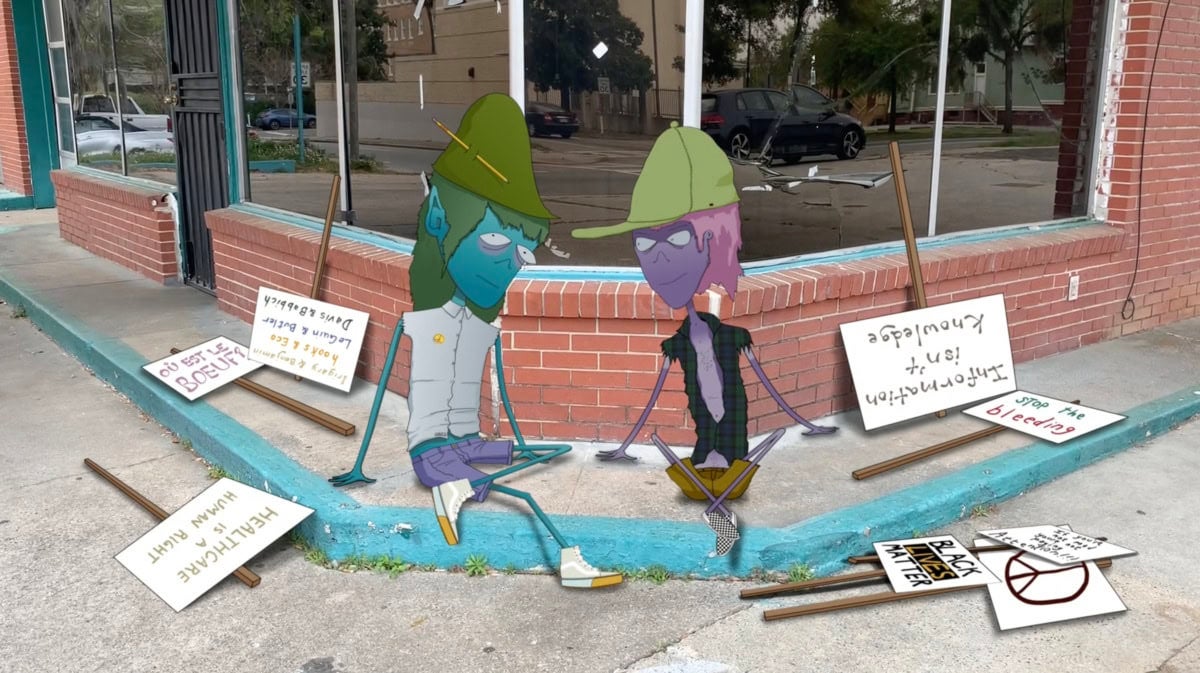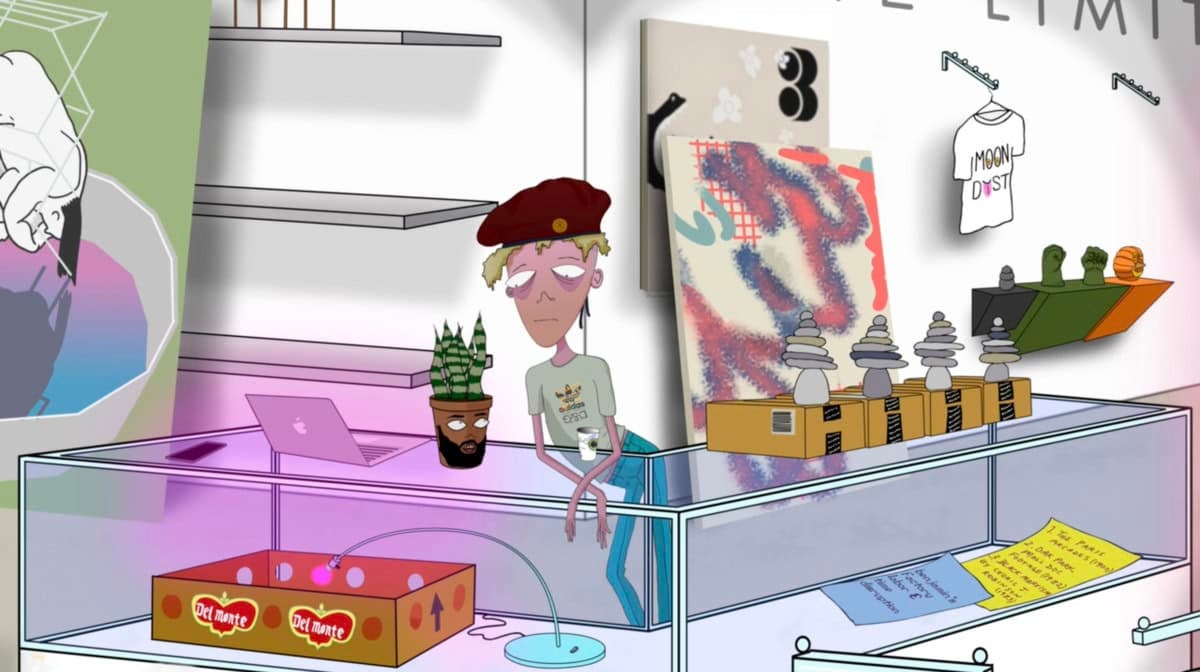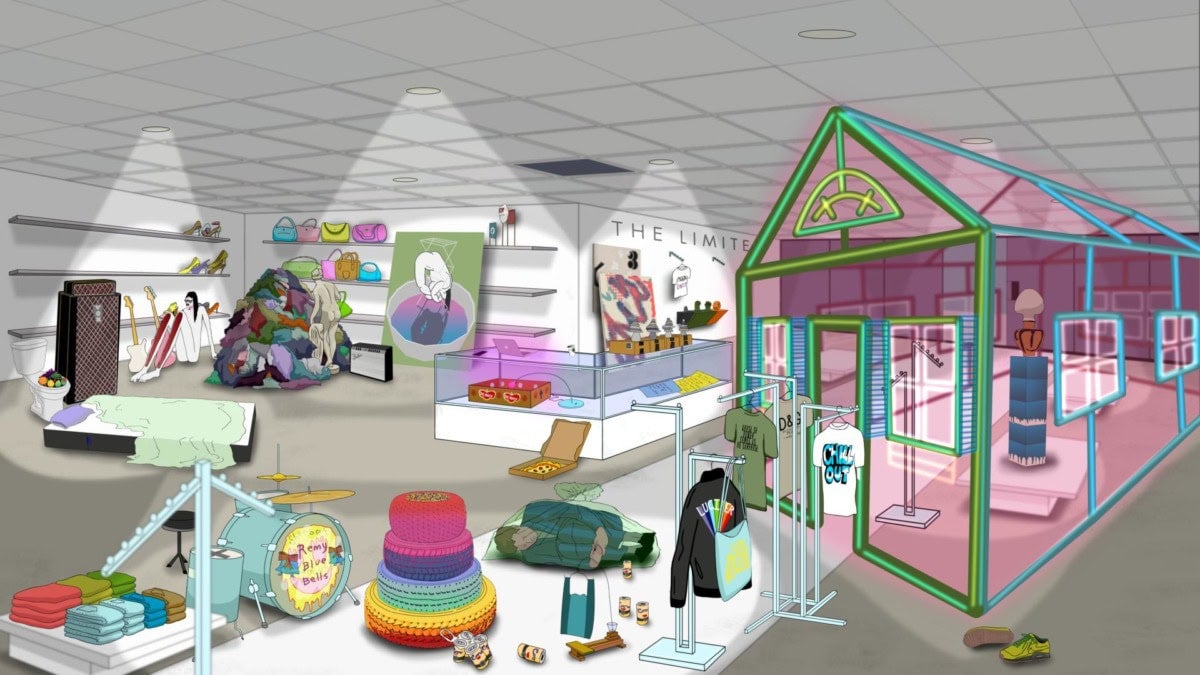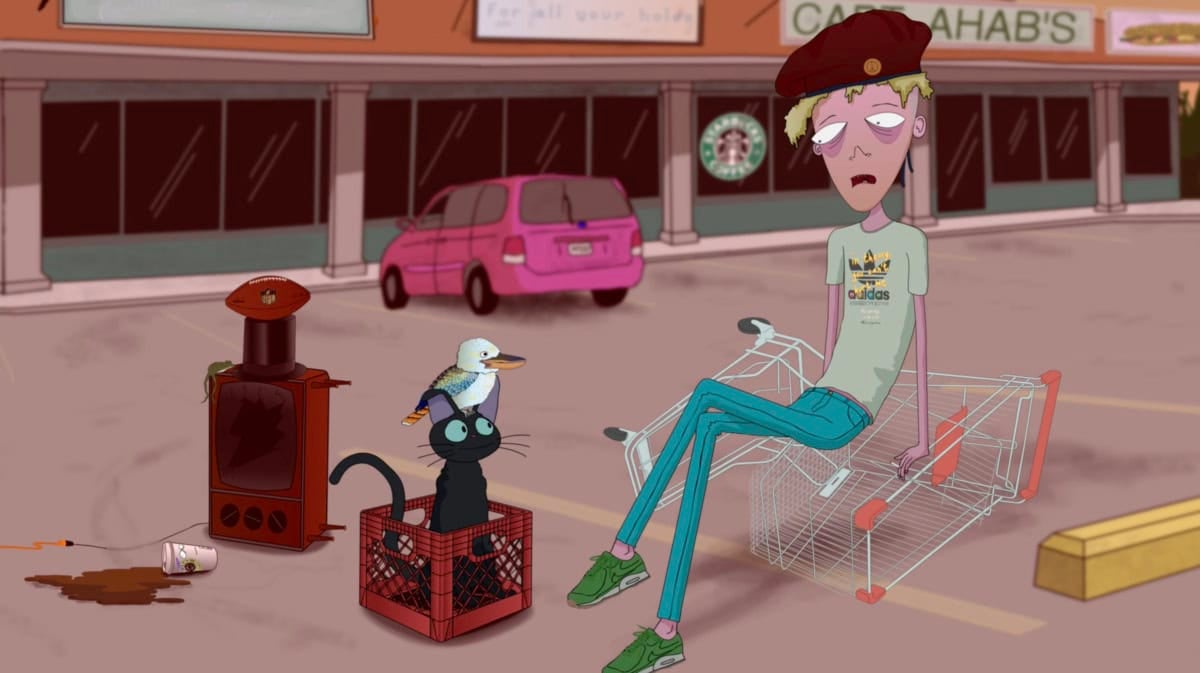
In the latest episode of Derek Larson’s animated series Très Mall, we see two young guys are sitting on the sidewalk outside an abandoned convenience store. They’ve parked themselves here before. Surrounding them are retired and discarded protest signs, artifacts of emotional turmoil strewn about. “Black Lives Matter.” “Healthcare is a Human Right.” “If you aren’t mad, you aren’t paying attention.” “Information is Knowledge.” “Où est le boeuf (where’s the beef).” It’s a short segment that repeats several times over. They are cartoons, cerebral and articulate animations living in the real world, awash in dissatisfaction. Looking at the mirrored reflection of the store windows behind them, chaos is nowhere to be found. Cars pass, pedestrians stroll by; these two have priceless brainy exchanges distilling complicated realities of who we as a people are deep down, as life around them rolls by, rhythmic and soothing. They are great satirists in the lineage of Statler and Waldorf, the cantankerous hecklers from the grandstand of The Muppet Show. Artists are born this way.
The animated show takes the formula of a variety show, a series of loosely interwoven vignettes, each accurately portraying the malaise of youth and enduring the search for some semblance of certainty. Très Mall is centered around a young artist named Jon, who inherited a strip mall in Savannah, Georgia. He, along with his two friends/ transform one of the empty storefronts, The Limited, into a life/work art studio and band practice space. Like a turtle’s sprint, their lives move slow and steady. With the help of a cast of cameos from various intelligentsia from the worlds of philosophy, art, environmentalism, and activism, we watch our heroes on an endlessly wayward quest to analyze trends, motives, and morals that lead to consumption’s psychological and cultural suffering. In a life of questions, each answer leads to greater dissatisfaction. Under the weight of that Georgia coast humidity, everything slows to a crawl. As glum as this might sound, the show shouldn’t be this much fun.
Episode five takes its title and inspiration from political scientist Nicole Sunday Grove’s writing Violence Entrepreneurs. The Associate Professor of Political Science at the University of Hawaii (Manoa) makes an appearance via a classic television set-up: a stage, the smartly dressed host, ‘on air’ and applause signs, large panning cameras, and a studio audience. The twist is that both Grove and the host are animated frogs. We see an amphibian Sunday Grove, wearing glasses and a purple blazer, discuss American citizen vigilantes often travel to decentralized battlefields in Iraq and Syria to fight against the Islamic State. The studio lives out in the lawn, Jon observes from above, peaking through tall blades of grass. The show is Dialektik der Aufklärung, which translates to Dialectic of Enlightenment (a text by Horkheimer and Adorno investigating the failure of human liberation). What’s laid out for us is an unreal tale of those that “vacation at war.” It’s a story Hollywood has sold us a thousand times, a Rambo-type being dropped behind enemy lines. Made permissible by the state, these are self-crafted missions, sovereign armies financed by platforms such as GoFundMe to eradicate another way of life. Her account is disturbing, violence a world away, creating emotional stress back home.
What follows is a conversation Derek and I had about the new episode and the project overall via email and zoom.
Daniel Fuller: How does the series change when you binge-watch the episodes together instead of taking them as ‘stand-alone’ experiences?
Derek Larson: I usually tell people new to the series to watch them in reverse because the order isn’t necessary and also because the newer episodes are technically better. It’s taken me 3 years to make 5 episodes, which is almost 2 hours of content. I’m improving the character design, colors and edits with each new episode, so there are distinct aesthetic differences in each of the episodes. I’m seeing my own archaic, classical, hellenistic development.
DF: Do you see a continuous narrative?
DL: The continuity is in the research. The main characters change with each new voice actor, which is ok because I’m actually seeking an awkward, Charlie Brown tempo. I’ll ask friends to read parts and usually go with first takes. So, the continuous thread is in the research and overall intent, which is an investigation of American consumerism and cultural hegemony. My lens is probably 30% Frankfurt School, inspired by Adorno & Horkheimer’s “Dialectic of Enlightenment” which sees the US as both a manufacturer and consumer of a “culture industry.” The first step in writing a new episode involves scanning academic papers and journals, finding papers I think are timely, relevant, daring, and well written. I’m also looking for good storytelling skills in the writing which means I should get a compelling performance in the interview. And this week I’ve been meeting with academics at UNAM in Mexico City and I’m finding interesting ways to thread topics in philosophy, politics, and the environment with themes of violence. I’m hearing very interesting perspectives on the effects of American capitalism from an outside perspective. I’m amazed how little I learned about pre-Colombian and Latin American history in public school.
DF: Do you write a script, or do the interviews sort of dictate where the narrative goes and where the script goes?
DL: There are basically two scripts, where one is threading journal articles and trying to find interesting connections, and then the other script is jokes and vignettes and little scenes that I think are funny. And then comes the fun task of trying to combine the two scripts. So in a lot of ways, you and I are maybe the same age, I’m thinking more and more that the show is resembling a variety show, like the original Muppets Show, or if you remember, Carol Burnett, where you have these moments and these vignettes that may or may not tie in to the previous, and it’s just these sort of punchlines.
DF: Each episode features a rotating cast of theorists, philosophers, economists, environmentalists, thinkers… I’ve wondered how much dialogue you had with these folks before making the videos?
DL: There isn’t much discussion beforehand and most of it is through email before we meet. It’s a weird request to get an email praising your paper which may not be widely read, and someone wants to make a cartoon about it. So, after initial skepticisms and emails I’ll send a list of questions specific to their writing which usually puts them in control as the expert in the scenario and they can lecture or perform, which most academics are great at.
DF: I am interested in the idea of exchange as an aspect of cultural practice. In each of the videos thus far, you have these conversations with great thinkers, never artists. Is that not of interest to you?

DL: Yes, I have a “greatest hits” list of artists I’d love to interview, most of whom are doing things involving communities and a social impact. Maybe these interviews will come later.
DF: There is this idea that artists possess this omnivorous curiosity, that they live these whimsically wayward lives, academically unmoored, skipping from new pursuit to new pursuit.
DL: And what you’ve just described as skipping from new pursuit to new pursuit is only part of an equation for what I think makes a great film, book or artwork. There needs to be brainstorming, floating, or dreaming in the creation process but also some level of execution that requires digging into and solidifying an argument. I learned this through animating where I need to begin my ideas in a playful and speculative way but then get very organized and detail oriented. In animation a great idea can come quickly but the execution is painstakingly slow. And in my opinion, when you combine these two ways of working the “gem” or final product is more polished and precious.
DF: Is Jon a self-portrait? Do you see yourself in the characters that make up Très Mall?
DL: He wasn’t at first but after so many people seeing him as me I finally gave into the idea. It’s my voice and he’s the vehicle driving the series, so I guess he is me. But with a perm.
DF: Can you tell us a bit about the decision to depict the visiting scholars as something other than themselves (be it a blue jay, a toad, a coffee cup, a book, etc.)?
DL: Because the first episode with Michael Hardt was so heavy, I thought it was a good idea to balance it with lighter/humorous visuals. So, I made him a blue jay and from there decided that the characters should be animals or objects. Now I ask each person I’m interviewing to choose a sort of avatar for themselves. They give me two options so I can see which looks better. This makes the interviews more like dream-states where Jon can encounter anyone at random and in any point of the story.
DF: Can we talk about The Limited? So many questions. First, as a retail women’s clothing and apparel brand, The Limited primarily lived in large-scale malls. How did this particular store come to be in a failed strip mall? Was The Limited chosen because it marks a time and place, an image in our collective imaginations of youth and freedom, now lost as the store exists solely online? Early on, we see the store repurposed as a near-empty band practice space / artist-run space that still holds reminders of its past (display shoes, handbags, and properly folded jeans). Sparsely mixed in were little art. A where’s Waldo’s like the Kenneth Anger Lucifer bomber jacket and a Scott Reeder Moon Dust tee hanging by its lonesome. Now the space is full of greatest hits, from Math Bass, Haim Steinbach, Michelangelo Pistoletto, Alex De Corte’s epic neon house. Are these works originals? Are they copies that Jon and his friends created themselves?

DL: I chose The Limited because it went bankrupt and closed all of its stores around the time I started the project, so its timeline matched with the series. I keep adding recognizable artworks into the store with artists like Math Bass, Laura Owens, Alex Da Corte, Daniel Keller, Josh Kline, Ebecho Muslimova, B. Wurtz, Rob Pruitt, Michaelangelo Pistoletto, Nicole Cherubini, Urs Fischer, Kenneth Anger, Haim Steinbach, Scott Reeder, Rebecca Ackroyd, etc., because I love their work and it’s fun to draw. In a way, I’ve created a scenario where a group of young artists recreate the work of others in a defunct retail/gallery space. And the scale of everything is a little off. I want to create an actual exhibition where half of the gallery is dark, with good audio, a typical screening space for the series, while the other half of the gallery feels like a retail/gallery space of handmade objects blending references to other artwork and clothing chains; post-retail sculpture. Like the Dia blended with Zara. Which until now I always thought of as commentary on consumer space but would equally be about institutional space. It will either premiere at Zwirner in 2024 or an abandoned strip mall on the outskirts of Walla Walla. I’ll keep you posted.
DF: Episode 5 presents many protest signs, but they have all been retired and discarded where they fall. Can you talk about their place in the modern landscape?
DL: The signs are footnotes. Instead of putting actual footnotes subtitled at the bottom of the screen I thought this was a better way to list references within the animation itself.
DF: We are told that “Très Mall follows three artists living in Savannah,” but we do not see the fruits of their artistic labor.
DL: Haha, don’t get me started! Their practice involves long walks and late-night dinners. You know? But you’re right, I probably should be focusing my energies on the fictional practice of cartoon artists right now.
DF: You recently relocated from Savannah to New York. How would you say, if at all, the pacing and subject matter of the episodes will change?
DL: The series moves with me which I love. As I said, I’m in Mexico City right now and the next episode also takes place here. Living in New York has changed the scope and ambition of the project, and all the parks are perfect for reading, thinking and people watching.
DF: Have you watched Dan Graham’s Death by Chocolate: West Edmonton Shopping Mall (1986-05)? To me, it makes megamall culture and architecture look like heaven.
DL: No but it looks amazing and it’s on EAI how have I missed this? I’ll rent it for my class this semester. But let me add an excellent documentary you may enjoy available on YouTube, it’s the opening of Oak Park Mall in Overland Park, Kansas 1982. It follows teenagers as they work and relax in one space making a closed, cultural loop of consumption and performance. And I love how the reporters, apparently new to the idea of malls, try to get the teens to answer existential questions about their existence, it’s very funny. And there’s the riveting “Mall City Documentary 1983 NYU Film of Roosevelt Field Mall Culture,” also available on YouTube. And let’s not forget to add the amazing and animated “OMG BFF LOL (Mall)” by Charlie White. Can we do a mall-themed screening somewhere?

DF: Have you been to American Dream yet? (For those not familiar, American Dream is the new $5 billion, 3-million-square-foot megamall and entertainment complex in New Jersey).
DL: I haven’t been yet but I really want to. I’m writing a paper right now on malls and online shopping, and I cover American Dream. It’s a total mess, but what newly constructed mega mall in the shadows of Amazon and during a pandemic wouldn’t be? I also write about mostly the first mall which was Northgate, in Seattle where I’m from. And coincidentally Amazon is also from Seattle, the biggest competitor to physical retail. Seattle has been an epicenter of the American “culture industry” at various points in history but has always played a role in its dissemination post-WWII through creating the first malls, large department store chains like Nordstrom and The Bon Marché, Starbucks, the best music (not debatable), and the control over shopping through Amazon, not including the various other tech companies. Half of the jets in the world are either designed or partly manufactured in the Seattle area. The city has an insane amount of creative output.
DF: Can you talk about the decision to place the videos online, free and accessible on a platform like DIS, instead of being available through a gallery?
DL: DIS has been a great team to work with. They host the series online, on AppleTV, and work with museums and institutions to organize exhibitions and screenings. They also provide great feedback when I need it.
DF: Do you feel like the series begin in Savannah?
DL: It began in Savannah, but it has since left Savannah with me. Yeah so, it’s been living in New York with me, and now it’s in Mexico City. So next summer it’ll be in Shanghai for three months with me, so the location is definitely changing. And so, I think Savannah as a character is playing less and less of a role.
DF: In episode 5, we see Jon head to New York City. He takes the subway, goes to Central Park, Grand Central, Julie Mehretu at the Whitney Museum. He never stops, only looks forward. The only time he seems at ease is in the park, on a blanket, with his friend from Savannah. In some ways, this mimics the dialog. Time and again, we see these ferociously intelligent passages presented only to have them lead us down an uncertain road. It seems to be a constant negotiation for hope.
DL: Jon is depressed. He’s a Charlie Brown-Daria-Morty-like character who is clearly smart, but the full force of the universe presents itself to him with most of its lessons going over his head. He grasps for information, asks big questions and seeks meaning. Jon is Socrates and the viewer is the philosopher. The Platonic dialogues have always had a big influence on me.
DF: Is there a world after this one?
DL: Are you asking me if I believe in the afterlife or if the series will continue? Let’s ask the Magic 8 Ball.




